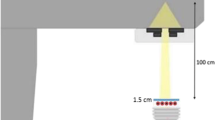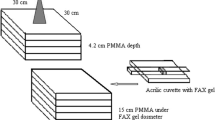Abstract
Ferrous xylenol orange (FXO) radiochromic gelatin gel dosimeter has the potential to provide tridimensional dosimetry for the assessment of new technologies of treatment in radiotherapy. However, one problem with the present formulations of these gels is the low melting point of the gelatin matrix. To solve this problem, formaldehyde was added to this gel dosimeter to promote crosslinking in the gelatin matrix, thus increasing the melting point. Five different formulations of FXO gel were tested, the best melting point temperature found was 62 °C or higher, and the 0.210 mm2/hr of diffusion rate was obtained on the 8% gelatin with 3% formaldehyde, 75% lower than original formulation. To provide clinical uses of these dosimeters, this work deals with the dosimetric characterization of modified FXO. No energy dependence was found when irradiated with 6 MV and 15 MV beams; also, no dose rate dependence was found varying low to high dose rate, 100 to 1400 cGy/min. These characteristics allow this dosimeter to useful for clinical context.








Similar content being viewed by others
Data Availability
No datasets were generated or analysed during the current study.
References
C. Baldock, Y. De Deene, S. Doran, G. Ibbott, A. Jirasek, M. Lepage, K.B. McAuley, M. Oldham, L.J. Schreiner, Polymer gel dosimetry. Phys. Med. Biol. 55(5), R1–R63 (2010)
L.J. Schreiner, Review of Fricke gel dosimeters. J. Phys: Conf. Ser. 3, 9–21 (2004)
H. Fricke, S. Morse, The chemical action of Roentgen rays on dilute ferrous sulphate solutions as a measure of dose Am. J Roent. Radium Ther. Nucl. Med 18, 430–432 (1927)
H. Fricke, H. Hart, Chemical dosimetry, vol. 2, in Radiation Dosimetry. ed. by F.H. Attix, W.C. Roesch (Academic Press, New York, 1955)
J.C. Gore, Y.S. Yang, R.I. Schulz, Measurement of radiation dose distributions by nuclear magnetic resonance (NMR) imaging. Phys. Med. Biol. 29, 1189–1197 (1984)
B. Gupta, S. Nilekani, Ferrous ion oxidations by H, OH and H2O2 in aerated FBX dosimetry system. Radiat. Phys. Chem. 53, 643–650 (1998)
M. Valente, W. Molina, L.C. Silva, R. Figueroa, F. Malano, P. Pérez, M. Santibañez, V. Vedelag, Fricke gel dosimeter with improved sensitivity for low-dose-level measurements Med. Phys. 17, 402–417 (2016)
N. Silva, P. Nicolucci, O. Baffa, Spatial resolution of magnetic resonance imaging Fricke-gel dosimetry is improved with a honeycomb phantom. Med. Phys. 30, 17–20 (2003)
A. Appleby, A. Leghrouz, Imaging of radiation dose by visible color development in ferrous-agarose-xylenol orange gels Med. Phys. 18, 309–312 (1991)
R.U. Kelly, K.J. Jordan, J. Battista, Optical CT reconstruction of 3D dose distributions using the ferrous benzoic-xylenol (FBX) gel dosimeter. Med. Phys. 25, 1741–1750 (1998)
K. Jordan, M. Sekimoto, Effects of adding glycerol and sucrose to ferrous xylenol orange hydrogel. J. Phys. Conf. Ser. 250, 012048 (2010). https://doi.org/10.1088/1742-6596/250/1/012048
S. Gallo, L. Cremonesi, G. Gambarini, L. Ianni, C. Lenardi, S. Argentiere, D. Bettega, M. Gargano, N. Ludwig, I. Veronese, Study of the effect of laponite on Fricke xylenol orange gel dosimeter by optical techniques. Sensor. Actuator. B Chem. 272, 618–625 (2018)
S. Gallo, E. Artus, M.G. Brambilla, G. Gambarini, C. Lenardi, A. Monti, A. Torresin, E. Pignoli, I. Veronese, Characterization of radiochromic PVA-GTA Fricke gels for dosimetry in X-rays external radiation therapy. J. Phys. D Appl. Phys. 52, 225601 (2019)
S. Babu, S. Peace, K. Rafic, E. Raj, S. Christopher, P. Ravindran, Escalation of optical transmittance and determination of diffusion coefficient in low Bloom strength gelatin-based Fricke gel dosimeters. Radiat. Phys. Chem. 156, 300–306 (2019)
K. Penev, K. Mequanint, Controlling sensitivity and stability of ferrous–xylenol orange–gelatin 3D gel dosimeters by do** with phenanthroline-type ligands and glyoxal. Phys. Med. Biol. 58, 1823–1838 (2013)
Y. Yang, L. Yang, J. Chen, B. Chen, W. Luo, G. Sui, X. Lu, J. Chen, Preparation and characterization of novel sulfosalicylic acid-ferrous-PVA hydrogel as a 3D dosimeter, J Radioanal. Nucl. Chem. 304, 481–487 (2015)
H.-W. Sung, D.-M. Huang, W.-H. Chang, R.-N. Huang, J.-C. Hsu, Evaluation of gelatin hydrogel crosslinked with various crosslinking agents as bioadhesives: in vitro study. J. Biomed. Mater. Res. 46(4), 520–530 (1999). https://doi.org/10.1002/(sici)1097-4636(19990915)46:4%3c520::aid-jbm10%3e3.0.co;2-9
P. Davis, B.E. Tabor, Kinetic study of the crosslinking of gelatin by formaldehyde and glyoxal. J. of Polym. Sci. 1, 799–815 (1963)
H.W. Sun, R.J. Feigal, H.H. Messer, Cytotoxicity of glutaraldehyde and formaldehyde in relation to time of exposure and concentration. Pediatr. Dent. 12, 303–307 (1990). PMID: 2128894
J.F. Pavoni, O. Baffa, An evaluation of dosimetric characteristics of MAGIC gel modified by adding formaldehyde. Radiat. Meas. 47(s 11–12), 1074–1082 (2012)
Y. **ao, S.F. Kry, R. Popple, E. Yorke, N. Papanikolaou, S. Stathakis, P. **a, S. Huq, J. Bayouth, J. Galvin, F.F. Yin, Flattening filter-free accelerators: a report from the AAPM Therapy Emerging Technology Assessment Work Group. J. Appl. Clin. Med. Phys. 16, 12–29 (2015)
S. Babic, J. Battista, K. Jordan, An apparent threshold dose response in ferrous xylenol-orange gel dosimeters when scanned with a yellow light source. Phys. Med. Biol. 53(6), 1637–1650 (2008)
T. Kron, D. Jonas, J.M. Pope, Fast T1 imaging of dual gel samples for diffusion measurements in NMR dosimetry gels. Magn. Reson. Imag. 15, 211–221 (1997)
J. Šolc, V. Spěváček, New radiochromic gel for 3D dosimetry based on Turnbull blue: basic properties. Phys. Med. Biol. 54, 5095–5101 (2009)
F.A. Osorio, E. Bilbao, R. Bustos, F. Alvarez, Effects of concentration, Bloom degree, and pH on gelatin melting and gelling temperatures using small amplitude oscillatory rheology. Int. J. Food Prop. 10(4), 841–851 (2007). https://doi.org/10.1080/10942910601128895
G. Gambarini, I. Veronese, L. Bettinelli, L. Felisi, M. Gargano, N. Ludwig, C. Lenardi, M. Carrara, G. Collura, S. Gallo et al., Study of optical absorbance and MR relaxation of Fricke xylenol orange gel dosimeters. Radiat. Meas. 106, 622–627 (2017)
Acknowledgements
We also acknowledge L. Rocha and C. Brunello for technical assistance and Hospital das Clinicas da Faculdade de Medicina de Ribeirão Preto, SP, Brazil, and Hospital do Amor, Barretos, SP, Brazil, for the use of their irradiation facilities. The help of the medical physicists G. Pavan and L. Borges of these institutions is greatly appreciated.
Funding
This work was supported by grants 2014/03370–6 and 2013/07699–0, São Paulo Research Foundation (FAPESP); CNPq Grant 304107/2019–0; and CAPES—Finance Code 001 for partial financial support.
Author information
Authors and Affiliations
Contributions
Conceptualization, M.A.d.S., J.F.P. and O.B.; Methodology, M.A.d.S., J.F.P., k.J. and O.B.; Software, M.A.d.S.; Validation, M.A.d.S., J.F.P., k.J. and O.B.; Formal analysis, M.A.d.S.; Investigation, M.A.d.S., J.F.P., k.J. and O.B.; Resources, M.A.d.S., J.F.P. and O.B.; Data curation, M.A.d.S.anf K.J.; Writing—original draft preparation, M.A.d.S.; Writing—review and editing, M.A.d.S., J.F.P., k.J. and O.B.; Visualization, K.J.; Supervision, J.F.P., k.J. and O.B.; Project administration, J.F.P., and O.B.; Funding acquisition, J.F.P. and O.B.
Corresponding author
Ethics declarations
Competing Interests
The authors declare no competing interests.
Additional information
Publisher's Note
Springer Nature remains neutral with regard to jurisdictional claims in published maps and institutional affiliations.
Rights and permissions
Springer Nature or its licensor (e.g. a society or other partner) holds exclusive rights to this article under a publishing agreement with the author(s) or other rightsholder(s); author self-archiving of the accepted manuscript version of this article is solely governed by the terms of such publishing agreement and applicable law.
About this article
Cite this article
da Silveira, M.A., Pavoni, J.F., Jordan, K. et al. Characterization of Radiochromic Hydrogel Dosimeter-Ferrous Xylenol Orange Enhanced to Have a Higher Melting Point. Braz J Phys 54, 168 (2024). https://doi.org/10.1007/s13538-024-01521-y
Received:
Accepted:
Published:
DOI: https://doi.org/10.1007/s13538-024-01521-y




